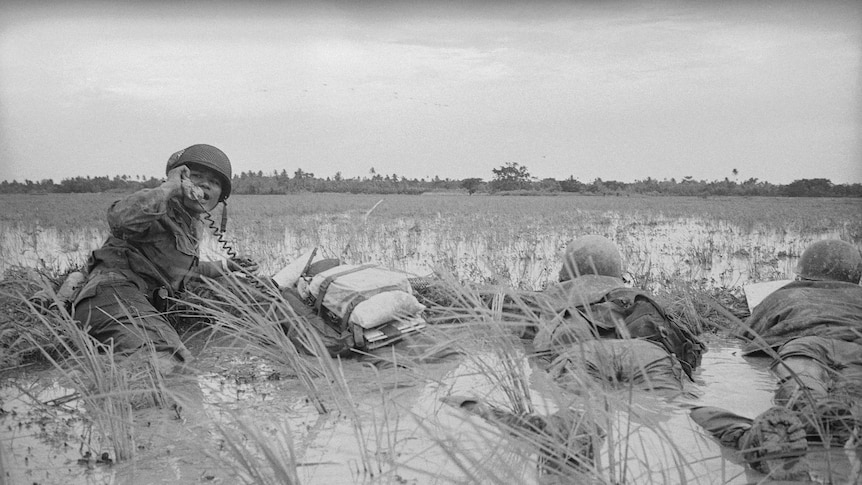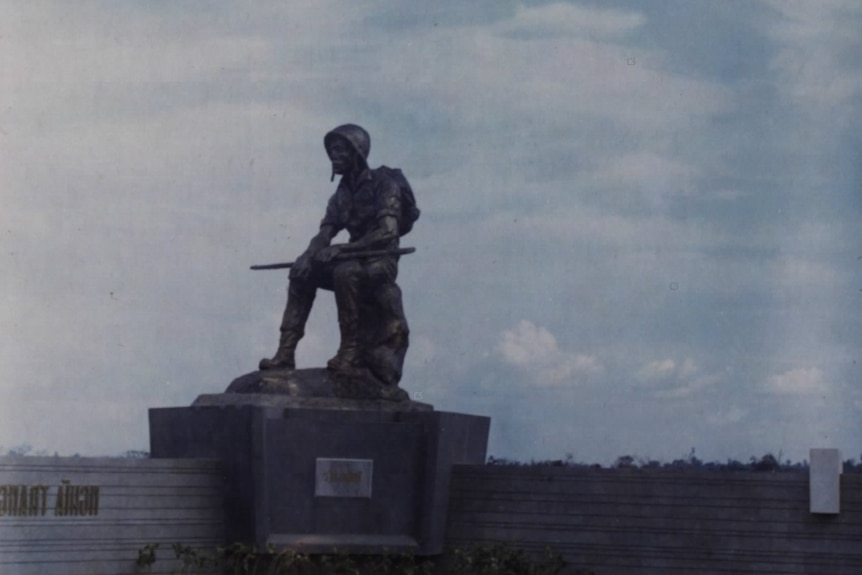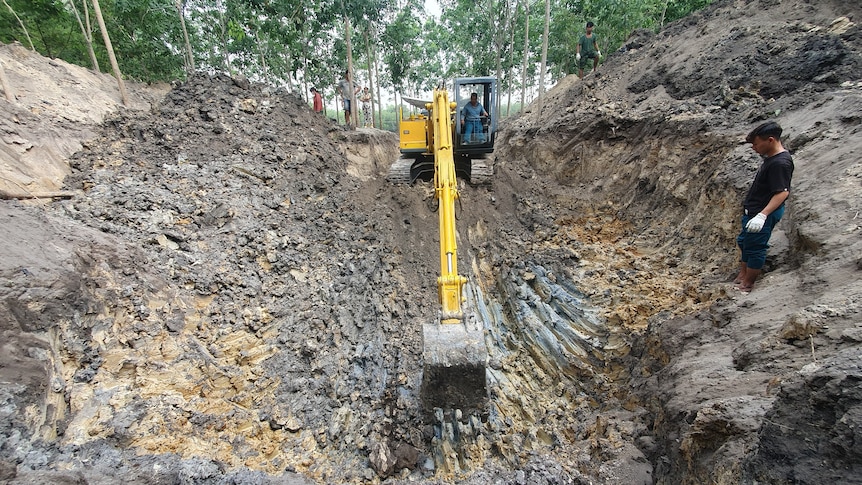
Một sĩ quan chỉ huy của Quân lực Việt Nam Cộng Hòa hét vào radio trong khi đơn vị của ông bị bao vây bởi hỏa lực mạnh của Việt Cộng trên đảo Tân Định vào tháng 9 năm 1965. (AP: Huỳnh Thanh Mỹ/Hồ sơ lưu)
Link:
abc.net.au/news/south-vietnamese-soldiers-long-to-bury-dead-soldiers/104828764
Hung Trần dừng lại khi kể về một ký ức đã ám ảnh ông suốt hàng chục năm, giọng ông run lên vì tức giận và đau buồn.
"Tôi vẫn còn nhìn thấy khuôn mặt của họ—những người anh em tôi đã chiến đấu cùng, những người đã không bao giờ trở về. Họ đã chiến đấu, đã đổ máu, và đã hy sinh vì đất nước," người cựu binh 73 tuổi, từng chiến đấu cho Việt Nam Cộng Hòa trong Chiến tranh Việt Nam, nói.
Lưu ý: Bài viết này có chứa một số hình ảnh có thể gây xúc động cho độc giả.
Nửa thế kỷ sau khi chiến tranh kết thúc, ông Trần và những người như ông vẫn đang đấu tranh để tìm và chôn cất thi thể của các đồng đội đã hy sinh.
"Họ không có mộ. Không có tên. Như thể họ chưa từng tồn tại," ông nói.
Nỗ lực tìm kiếm và hồi hương hài cốt
Tổ chức Vietnamese American Foundation (VAF) và các thành viên của tổ chức này, bao gồm cả ông Hung Trần (bên phải), đã làm việc hàng thập kỷ để đưa hài cốt các liệt sĩ Việt Nam Cộng Hòa trở về. (Cung cấp)
Nghĩa trang Quân đội Biên Hòa, nằm bên ngoài Sài Gòn—nay là TP.HCM—từng là một "nơi thiêng liêng" trước năm 1975, ông Trần, người đã sống ở Úc 40 năm sau khi chạy khỏi Việt Nam với tư cách là người tị nạn, nói.
"Nhưng sau khi cộng sản chiếm đóng, họ đã phá hủy nó. Họ đập nát bia mộ, đào bới phần mộ và trồng cây để che đi dấu tích.
"Mục đích của họ rất rõ ràng: xóa chúng tôi khỏi lịch sử."
Một bức tượng lớn của một người lính mệt mỏi từng đánh dấu lối vào Nghĩa trang Quân đội Biên Hòa trước khi nó bị phá hủy sau khi Việt Nam Cộng Hòa thất thủ. (Wikipedia: NARA photo 111-CCV-47-CC37503 bởi SFC Kazuo Uchima)

Nhà sử học người Úc Robert Hall, người đã hỗ trợ chính phủ Việt Nam trong việc tìm kiếm nơi chôn cất các liệt sĩ Bắc Việt và trao trả các di vật cá nhân thu thập được từ chiến trường, nói rằng thời gian không còn nhiều để tìm kiếm hài cốt của các binh sĩ Việt Nam Cộng Hòa.
"Ngay sau chiến tranh, tình hình cực kỳ khắc nghiệt. Các nghĩa trang quân sự của Việt Nam Cộng Hòa đã bị chính phủ san bằng," ông nói.
Dù thái độ đã dần thay đổi và có những bước tiến, Tiến sĩ Hall cho biết "những nhạy cảm đặc biệt" khiến việc tìm kiếm hài cốt càng thêm khó khăn.
Đại sứ Việt Nam tại Úc, ông Phạm Hùng Tâm, nói rằng chính phủ đã cho phép thân nhân khôi phục và di dời mộ phần của các binh sĩ Việt Nam Cộng Hòa tại các nghĩa trang như Bình An—trước đây là Nghĩa trang Quân đội Biên Hòa—nay đã trở thành nghĩa trang dân sự.
"Hàng nghìn ngôi mộ đã được thân nhân phục hồi, nhiều ngôi mộ đã được xây lại bằng xi măng," ông Tâm nói với ABC.
Nghĩa trang đã thực hiện công tác vệ sinh và tu bổ, bao gồm việc dựng các bàn thờ bằng đá, ông nói thêm.
Về thách thức trong việc tìm kiếm hài cốt, ông Tâm cho biết: "Nhiệm vụ tìm kiếm hài cốt của những người này là vô cùng lớn, đầy thách thức, tốn kém và mất nhiều thời gian.
"Ngay cả hàng nghìn liệt sĩ của chúng tôi vẫn còn chưa được tìm thấy."
Thách thức tìm kiếm hài cốt binh sĩ Việt Nam Cộng Hòa
Sau khi Chiến tranh Việt Nam kết thúc vào năm 1975, ước tính khoảng 165.000 binh sĩ Việt Nam Cộng Hòa đã bị đưa đến các "trại cải tạo" ở miền Bắc Việt Nam, theo Trung tâm Dart của Đại học Columbia.
Ông Trần, một người sống sót từ trại cải tạo, mô tả đó là một "địa ngục tra tấn" đối với những đồng đội của ông.
"Nhiều người đã chết vì đói khát, tra tấn hoặc bệnh tật. Họ bị chôn cất trong những khu rừng xa xôi, trên các dãy núi hoang vu, không một tấm bia, không một dấu tích," ông nói.
"Gia đình họ không thể tìm ra họ, chứ đừng nói đến chuyện đưa họ về quê hương."
Nửa thế kỷ trôi qua, các cựu chiến binh Việt Nam Cộng Hòa vẫn tiếp tục cuộc chiến tìm kiếm và chôn cất các đồng đội của mình. (Reuters/Tư liệu)
Tiến sĩ Hall, một cựu binh Úc và giảng viên danh dự tại Đại học UNSW Canberra, giải thích rằng việc tìm kiếm hài cốt binh sĩ Việt Nam Cộng Hòa là một nhiệm vụ đặc biệt khó khăn.
"Đối với binh sĩ Bắc Việt và Việt Cộng, thi thể của họ thường nằm lại trên chiến trường," ông nói.
"Họ không có báo cáo chi tiết hay vị trí chôn cất chính xác như chúng tôi. Trong nhiều trường hợp, họ chỉ ghi lại những thông tin rất chung chung—như một đồn điền cao su hoặc một khu vực rộng hàng nghìn mẫu đất."
Các tổ chức như Vietnamese American Foundation vẫn tiếp tục kêu gọi việc hồi hương hài cốt binh sĩ Việt Nam Cộng Hòa về với gia đình họ.
Cho đến nay, tổ chức này đã tìm lại được 504 hài cốt, nhưng vẫn còn rất nhiều người chưa được xác định danh tính và đưa về quê nhà.
Năm 2010, tổ chức này đã khai quật nghĩa trang trại cải tạo Làng Đá ở tỉnh Yên Bái, thu được 12 bộ hài cốt—trong đó 11 bộ có thể xét nghiệm ADN.
"Mọi người muốn quét sạch chúng tôi khỏi lịch sử"
Mỗi năm, các cựu binh Mỹ và Úc đều quay lại Việt Nam để tưởng niệm đồng đội đã khuất.
Nhưng với ông Trần, điều đó chỉ làm tăng thêm nỗi đau vì không thể đưa đồng đội của mình về nơi an nghỉ cuối cùng.
"Làm sao chính quyền Việt Nam có thể nói về hòa giải với kẻ thù cũ, trong khi đối xử với chúng tôi—những người cùng ngôn ngữ, cùng màu da, cùng lịch sử—như kẻ thù?"
"Đây là một sự tàn nhẫn mà không ai ngoài người Việt có thể thực sự thấu hiểu," ông nói.
Nhưng ông Tâm từ đại sứ quán Việt Nam cho biết chính phủ luôn coi cộng đồng người Việt hải ngoại, bao gồm cả những người từng thuộc chế độ Việt Nam Cộng Hòa, là một phần không thể tách rời của dân tộc Việt Nam.
Dù vậy, ông Trần nói rằng cuộc chiến tìm kiếm những người đã mất vẫn là trận chiến lớn nhất đời ông.
"Chúng tôi không còn chính phủ đại diện. Chúng tôi như những hạt bụi—mọi người đều muốn quét chúng tôi đi," ông nói.
"Nhưng chúng tôi sẽ không dừng lại. Những người đó đã hy sinh vì lý tưởng của họ. Họ xứng đáng được nhớ đến."
Bản dịch ChatGTP & HSP
South Vietnamese want to find and bury
their war dead. Why is it so hard?

A South Vietnamese commander yells into a pack radio as his unit is encircled by heavy Viet Cong fire on Tan Dinh Island in September 1965. (AP: Huynh Thanh My/File)
Hung Tran pauses as he recounts a memory that has haunted him for decades, his voice trembling with anger and sorrow.
"I can still see their faces — the men I served with, the ones who didn't come home. They fought, they bled, and they died for their country," said the 73-year-old, who fought for South Vietnam in the Vietnam War.
Warning: This story contains some imagery that readers might find confronting.
Half a century since the war ended, Mr Tran and others like him are still fighting to locate and bury the bodies of their fallen comrades.
"They have no graves. No names. It's like they never existed," he said.
The Vietnamese American Foundation and its members, including Hung Tran (right) have been working to repatriate bodies of South Vietnamese soldiers for decades. (Supplied)
The Bien Hoa National Military Cemetery outside Saigon — now Ho Chi Minh City — was a "sacred place" before 1975, said Mr Tran, who has lived in Australia for 40 years after fleeing Vietnam as a refugee.
"But after the communists took over, they destroyed it. They smashed the tombstones, dug up the graves, and planted trees to cover the land.
"Their aim was clear: to erase us from history."
Australian historian Robert Hall, who has aided the Vietnamese government in locating burial sites of North Vietnamese soldiers and returning personal artefacts recovered from the battlefield, says time is running out to find the remains of South Vietnamese troops.
"It was extremely nasty straight after the war. South Vietnamese military cemeteries were bulldozed by the government," he said.
While attitudes have softened and progress had been made, Dr Hall said "added sensitivities" made the logistics of locating remains even more difficult.
Vietnam's ambassador to Australia, Pham Hung Tam, said the government had allowed relatives to restore and relocate graves of South Vietnamese soldiers at cemeteries such as Binh An — formerly the Bien Hoa National Military Cemetery — which is now a civilian cemetery.
"Thousands of these graves have been restored by relatives, many of which have been cemented," Mr Tam told the ABC.
The Vietnamese American Foundation has been working to restore the graves at the Bien Hoa National Military Cemetery, now known as the Binh An Cemetery. (Supplied: Vietnamese American Foundation)
The cemetery had undertaken cleaning and refurbishing efforts, including the erection of stone altars, he added.
On the broader challenge of finding remains, Mr Tam said: "The task of locating the remains of these individuals is immense, challenging, costly, and time-consuming.
"Even thousands of our patriotic martyrs remain unaccounted for."
The challenge of finding South Vietnamese soldiers
After the Vietnam War ended in 1975 an estimated 165,000 soldiers were sent to "re-education camps" in North Vietnam, according to Columbia University's Dart Center.
Mr Tran, a survivor of one such camp, described it as a "torturous place" for his South Vietnamese comrades.
"Many died from starvation, torture, or illness. They were buried in remote forests and mountains, their graves unmarked," he said.
"Their families had no way to find them, let alone bring them home."
Half a century since the war ended, South Vietnamese veterans are still fighting to locate and bury the bodies of their fallen comrades. (Reuters/File)
Finding the remains of fallen soldiers after the Vietnam War was especially difficult explained Dr Hall, himself an Australian veteran and honorary lecturer at UNSW Canberra.
"For North Vietnamese and Viet Cong soldiers, their bodies tended to remain on the battlefield," he said.
"They didn't have detailed reports or precise burial locations like we did. In many cases, they'd report burials in vague terms — like a rubber plantation or a district covering thousands of acres."
Organisations such as the Vietnamese American Foundation continue to advocate for the return of South Vietnamese soldiers' remains to their families.
It has recovered 504 remains so far, with many more still awaiting identification and return.
The organisation excavated the Lang Da re-education camp cemetery in Yen Bai province in 2010, recovering 12 skeletons — 11 of which yielded viable DNA.
The remains of a South Vietnamese soldier found in 2006 as part of efforts by the Vietnamese American Foundation and a team of experts including an archaeologist. (Supplied: Vietnamese American Foundation)
A team exhumed skeletons and unearthed personal items such as ceramic bowls and toothbrushes over several days despite challenging soil and climate conditions, archaeologist Julie Martin later wrote for an academic journal.
But the Vietnamese American Foundation's advocacy efforts with the US and Vietnamese governments were often slow and arduous, Mr Tran said.
The foundation has proposed rebuilding the Bien Hoa National Military Cemetery, but there has been little progress with the Vietnamese government.
"We don't want any fanfare or politics, just a dignified resting place," Mr Tran said.
The Vietnamese American Foundation has recovered 504 remains of former South Vietnamese soldiers over decades of work. (Supplied: Vietnamese American Foundation)
'Everyone wants to sweep us away'
Every year, US and Australian veterans return to Vietnam to commemorate their dead.
Photo shows An excavator digging into the earth.

A man's questions about his veteran father's service led him to a filled-in bomb crater.
They even partake in events marking the anniversary of the Battle of Long Tan.
For Mr Tran, that compounds the pain of not being able to lay his fellow soldiers to rest.
"How can the Vietnamese communists claim to reconcile with their former enemy while treating us — people who share the same language, skin colour, and history — as enemies?
"It's a cruelty that nobody who isn't Vietnamese can truly understand," he said.
But the Vietnam embassy's Mr Tam said diaspora members, including prominent members of the South Vietnamese regime, had been welcomed back to the country as part of reconciliation efforts.
"The Vietnamese government has always regarded overseas Vietnamese as an inseparable part of the Vietnamese nation," he said.
Despite Australian veterans being able to commemorate their fallen in Vietnam, many South Vietnamese soldiers feel they may never be extended the same opportunity. (Reuters: Kham )
The rights of overseas Vietnamese including the South Vietnamese were "equivalent to those of any Vietnamese citizen", he added.
Mr Tran said locating lost South Vietnamese soldiers remained the greatest battle he will ever fight.
"We don't have a government to represent us anymore. We're like dust — everyone wants to sweep us away," he said.
"But we won't stop fighting. Those men gave their lives for something they believed in. They deserve to be remembered."
Vietnam veteran, homeless for 30 years, receives war medals, reunites with family 🎖️ | ABC Australia.


No comments:
Post a Comment